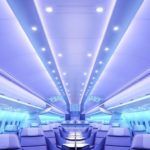Airspace is Your Space: Airbus Unveils Passenger-Centric Cabin Brand
Share

APEX Insight: Drawing upon A350 XWB cabin interiors and features, Airbus’ Airspace brand will debut on its A330neo fleet and will establish a consistent cabin design language across the aircraft family. Beyond enhancements in comfort and ambience, Airspace also marks an endeavor from the airframer to engage more directly with airline passengers.
On March 23, from the top floor of the iconic Gherkin building in London, top executives from Airbus unveiled Airspace, the airframer’s signature cabin interior design brand. The passenger-focused cabin interior transfers innovations and concepts from the long-range widebody A350XWB aircraft to the A330neo, which will roll out late 2017, and will eventually be rolled out across the entire Airbus family.
“I’m really happy and proud that we have decided on a name and brand for our product,” said Ingo Wuggetzer, vice-president, Cabin Marketing, during the presentation. “Airspace is built on strong values and clear and simple attributes.” Underpinning the design philosophy is the perception of spaciousness, facilitated by a higher ceiling, long parallel lines and lateral luggage bins that accommodate 66 percent more luggage. A full spectrum of ambient, LED light scenarios allows airlines to customize the mood and atmosphere of the cabin, while strategically placed light fixtures lend the appearance of floating cabin elements. Refreshed lavatories and quiet cabin technology contribute to a relaxing ambience.
Through the introduction of smarter monuments and a repositioning of the crew rest area, Airbus reports that up to 10 seats were gained without compromising on comfort. “Comfort in economy class is all about personal space,” explained Wuggetzer. According to studies conducted by Airbus, increasing the width of seats has more impact than an increased pitch, especially as it provides more shoulder space. Airspace establishes an 18-inch width standard for eight-abreast seating on the A330neo, and despite the fact that Airbus is willing to trim width for higher-density layouts at airline request, the airframer is confident that a benchmark level of comfort will be maintained.
Combined with seat width standards, a forth generation in-flight entertainment (IFE) system is integrated with a smaller and more optimally positioned seat box to allow for more legroom. Large high-definition, 3-D and device-integrated IFE options will be transferred from the A350, with line-fit connectivity from a range of suppliers available as well.
Beyond establishing a uniform brand and design language, Airspace marks an endeavor from the airframer to engage more directly with airline passengers. “What’s happening is, because of social media, passengers are starting to differentiate one aircraft from another,” said Kiran Rao, executive vice-president, Strategy and Future Programmes. “Now when they book on social media, travelers are comparing the experience they’re going to have from one airline to another. Today, we are reaching out to the passengers that are going to be flying on our aircraft… We want a passenger to check when they’re booking a flight and book an Airspace cabin.”
Airbus will showcase a mock-up of the A330neo Airspace cabin at the Aircraft Interiors Expo this April in Hamburg, Germany.






